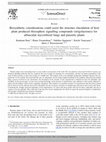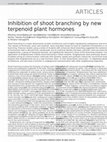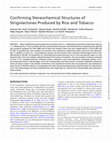Papers by Koichi Yoneyama

Strigolactones (SLs) are carotenoid-derived signaling molecules that mediate symbiotic and parasi... more Strigolactones (SLs) are carotenoid-derived signaling molecules that mediate symbiotic and parasitic communications in the rhizosphere and plant hormones that regulate the growth and development of plants through crosstalk with other hormones. Natural SLs are classified into two groups based on the stereochemistry of the B–C ring junction. Rice and sorghum plants, both gramineous crops, produce orobanchol-type and strigol-type SLs, respectively, while tobacco plants produce both types. In the present study, we demonstrate that such species-specific phenomena in SL production also occur in the transport of exogenous SLs from roots to shoots. In rice plants, strigol-type SLs such as 5-deoxystrigol have been reported to actively inhibit tiller bud outgrowth, whereas root-applied strigol-type SLs could not be detected in shoots harvested 20 hr after treatment, indicating that metabolites of SLs or other signaling compounds downstream of SLs—but not SLs themselves—are the true inhibitors of tiller bud outgrowth. Electronic supplementary materials: The online version of this article contains supplementary material (analytical conditions), which is available at http://www.jstage.jst.go.jp/browse/jpestics/.

Plant Physiology and Biochemistry, 2008
Parasitic plants cause devastating losses to crop yields in several parts of the world. The root ... more Parasitic plants cause devastating losses to crop yields in several parts of the world. The root parasites, Striga and Orobanche species, use chemical signalling molecules that are exuded by the roots of plants in extremely low concentrations, and that can induce germination of the seeds of these parasites, to detect the vicinity of a suitable host. The majority of the so far identified germination stimulants belong to the strigolactones. It was recently discovered that this class of compounds can also induce hyphal branching in the symbiotic arbuscular mycorrhizal fungi, a process involved in root colonisation. The elucidation of the structure of new strigolactones is hindered by their low abundance and instability. In the present paper, we have used existing knowledge on the structure of strigolactones and combined it with recently obtained insight in the biosynthetic origin of these signalling compounds. This enabled us to postulate structures for strigolactones that have been isolated but for which so far the structure has not been elucidated, but also to propose structures of strigolactones that may be discovered in the future. Considering the strongly increased importance of the strigolactones, we expect that more groups will look for these compounds and also in systems so far not exploited. This could lead to the discovery of new strigolactones for which we expect the present biogenetic considerations will facilitate identification and structure elucidation.

Nature, 2008
Shoot branching is a major determinant of plant architecture and is highly regulated by endogenou... more Shoot branching is a major determinant of plant architecture and is highly regulated by endogenous and environmental cues. Two classes of hormones, auxin and cytokinin, have long been known to have an important involvement in controlling shoot branching. Previous studies using a series of mutants with enhanced shoot branching suggested the existence of a third class of hormone(s) that is derived from carotenoids, but its chemical identity has been unknown. Here we show that levels of strigolactones, a group of terpenoid lactones, are significantly reduced in some of the branching mutants. Furthermore, application of strigolactones inhibits shoot branching in these mutants. Strigolactones were previously found in root exudates acting as communication chemicals with parasitic weeds and symbiotic arbuscular mycorrhizal fungi. Thus, we propose that strigolactones act as a new hormone class-or their biosynthetic precursors-in regulating above-ground plant architecture, and also have a function in underground communication with other neighbouring organisms.

Major strigolactones (SLs) produced by rice (Oryza sativa L. cv. Nipponbare) and tobacco (Nicotia... more Major strigolactones (SLs) produced by rice (Oryza sativa L. cv. Nipponbare) and tobacco (Nicotiana tabacum L. cv. Michinoku No. 1) were purified and their stereochemical structures were determined by comparing with optically pure synthetic standards for their NMR and CD data and retention times and mass fragmentations in ESI–LC/MS and GC–MS. SLs purified from root exudates of rice plants were orobanchol, orobanchyl acetate, and ent-2'-epi-5-deoxystr-igol. In addition to these SLs, 7-oxoorobanchyl acetate and the putative three methoxy-5-deoxystrigol isomers were detected by LC–MS/MS. The production of 7-oxoorobanchyl acetate seemed to occur in the early growth stage, as it was detected only in the root exudates collected during the first week of incubation. The root exudates of tobacco contained at least 11 SLs, including solanacol, solanacyl acetate, orobanchol, ent-2'-epi-orobanchol, orobanchyl acetate, ent-2'-epi-orobanchyl acetate, 5-deoxystrigol, ent-2'-epi-5-deoxystrigol, and three isomers of putative didehydro-orobanchol whose structures remain to be clarified. Furthermore, two sorgolactone isomers but not sorgolactone were detected as minor SLs by LC–MS/MS analysis. It is intriguing to note that rice plants produced only orobanchol-type SLs, derived from ent-2'-epi-5-deoxystrigol, but both orobanchol-type and strigol-type SLs, derived from 5-deoxystrigol were detected in tobacco plants.
Strigolactones (SLs) mainly produced in roots move upward to shoots and inhibit axillary bud outg... more Strigolactones (SLs) mainly produced in roots move upward to shoots and inhibit axillary bud outgrowth. However, SLs were not detected by LC-MS/MS in xylem saps collected from rice, tomato, cucumber, tobacco, sorghum, and Arabidopsis. d 1-Orobanchol and d 6-4-deoxyorobanchol that were fed to roots of rice plants were detected in shoots harvested 20 hr after treatment, although not in the xylem sap. These results imply that both endogenous and exogenous SLs are transported from roots to shoots, although not through the xylem.

Pest Management Science, 2016
Seed germination is a key phase of the parasitic plant life cycle which is stimulated by the seco... more Seed germination is a key phase of the parasitic plant life cycle which is stimulated by the secondary metabolites, mainly strigolactones (SLs), secreted by the host roots. Interventions during this stage would be particularly suitable for parasitic weed management practices since blocking these chemical signals would prevent seed germination and thus parasite attack. Four fungal strains with different ecological functions were considered for their possible capability to metabolize SLs, i.e.: Fusarium oxysporum and F. solani, biocontrol agents of Phelipanche ramosa; Trichoderma harzianum, a potential biopesticide; Botrytis cinerea, a phytopathogenic fungus. Four different SLs (i.e. the natural strigol, 5-deoxystrigol (5DS) and 4-deoxyorobanchol (4DO), and the synthetic analogue GR24) were added to fungal cultures, followed by the determination of the SL content by liquid chromatography-tandem mass spectrometry. Differences were observed among microorganisms, treatments and SLs used. T. harzianum and F. oxysporum were the most capable to reduce the SL content; considering the whole set of fungi used, 5DS and 4DO proved to be the most degradable SLs. Beneficial microscopic fungi could differently be used for biocontrolling parasitic weeds, acting as a "physiological" barrier, by preventing the germination of their seeds due to the capability of bio-transforming the stimulatory signals.

Allelochemicals are the chemicals released from donor organisms into the environment and affect g... more Allelochemicals are the chemicals released from donor organisms into the environment and affect growth and development of receiver organisms. Allelochemicals involved in the plant–plant interactions can be classified according to their chemistries: alkaloids, terpenoids, phenolic compounds, benzoxazinoids, glucosinolates and isothiocyanates, and others. Most of these allelochemicals inhibit seed germination and/or seedling growth; some of them show promotive effects such as strigolactones, which trigger seed germination of root parasitic plants.By contrast, allelochemicals involved in plant–microbe interactions have rather defined roles than those that participate in plant–plant interactions and are categorized on their biological functions as molecular signals to establish symbiotic relationships passed between legumes and leguminous bacteria and between most of terrestrial plants and arbuscular mycorrhizal fungi, attractants of motile zoospores or spore germination inducers secreted by host plants of phytopathogenic fungi, self-defensive chemicals in plants and allelochemicals in aquatic ecosystems, and so on.
Journal of Weed Science and Technology, 1995
Parasitic Orobanchaceae, 2013
Weed Biology and Management, 2001
Pest Management Science, 2012
Strigolactones are a class of bioactive natural metabolites produced by plant roots and released ... more Strigolactones are a class of bioactive natural metabolites produced by plant roots and released into the rhizosphere. They were discovered as signals indispensable for the induction of germination of seeds of root parasitic weeds, but since then, interestingly, many other biological, physiological and ecological roles have been described. This has suddenly provoked huge scientific interest in these compounds within different research fields. In this short perspective the attention is focused mainly on the ongoing and future research aimed at deciphering the biological roles of strigolactones that could positively affect, more or less directly, the management of parasitic weeds.
Journal of Agricultural and Food Chemistry, 1998
... Cotylenins and Fusicoccins Stimulate Seed Germination of Striga hermonthica (Del.) Benth and ... more ... Cotylenins and Fusicoccins Stimulate Seed Germination of Striga hermonthica (Del.) Benth and Orobanche minor Smith. ... below). Stimulation of Seed Germination ofOrobanche Species by Ophiobolin A and Fusicoccin Derivatives. ...
Studies in Natural Products Chemistry, 2002
Tetrahedron Letters, Aug 1, 2009
ABSTRACT The structure proposed for solanacol, the germination stimulant for seeds of root parasi... more ABSTRACT The structure proposed for solanacol, the germination stimulant for seeds of root parasitic weeds isolated from tobacco (Nicotiana tabacum L.), was synthesized. Comparison of the 1H NMR data of the synthetic compounds with those reported for solanacol showed the previously proposed structure to be incorrect.

Bioscience Biotechnology and Biochemistry, Feb 1, 2008
Arabidopsis thaliana (Arabidopsis) treated with the four stereoisomers of Brz220 (2RS, 4RS-1-[4-p... more Arabidopsis thaliana (Arabidopsis) treated with the four stereoisomers of Brz220 (2RS, 4RS-1-[4-propyl-2-(4-trifluoromethylphenyl)-1, 3-dioxane-2-ylmethyl]-1H-1, 2, 4-triazole) showed a dwarf phenotype like brassinosteroid (BR) biosynthesis mutants that were rescued by treatment of BRs. The target sites of each Brz220 stereoisomer were investigated by treatment of Arabidopsis with BRs in the dark. The results suggest that the stereoisomers block the 22-hydroxylation step in BR biosynthesis. This step is catalyzed by DWF4, an Arabidopsis cytochrome P450 identified as a steroid 22-hydroxylase. The enzyme was expressed in E. coli, and the binding affinity of the stereoisomers to recombinant DWF4 was analyzed. The results indicate that in these stereoisomers there exists a positive correlation between binding affinity to DWF4 and inhibition of Arabidopsis hypocotyl growth. In this context, we concluded that DWF4 is the target site of Brz220 in Arabidopsis.
植物化学調節学会研究発表記録集, Oct 31, 2002






Uploads
Papers by Koichi Yoneyama